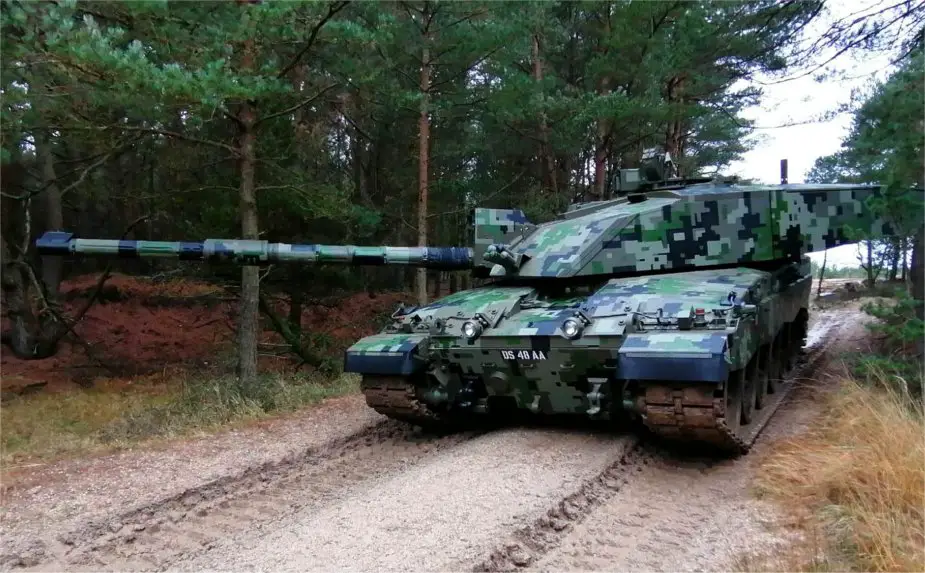Breaking news
United Kingdom signed a £50M deal to support and train Ukraine's Military.
On July 12, 2023, the United Kingdom Ministry of Defense awarded a £50 million contract to Babcock in order to provide operational support to Ukraine's military land assets, enhancing their capabilities in the field. Over a span of 12 months, Babcock will extend their expertise to Ukraine's armored vehicles, including the Challenger 2 tanks and Combat Vehicle Reconnaissance (Tracked) units.
Follow Army Recognition on Google News at this link

The Challenger 2 is the Main Battle Tank in service in the United Kingdom (Picture source The Tank Museum)
In addition to this, the company will deliver training to Ukrainian personnel and oversee the management of equipment, supply chains, and spare parts. The contract aims to deliver flexible and scalable support to the Armed Forces of Ukraine (AFU) by leveraging Babcock's expertise as the prime contractor, in collaboration with vehicle manufacturers Rheinmetall, BAE Systems, and RBSL.
Babcock, a global support services provider specializing in managing complex assets and critical infrastructure, is well-positioned for the contract due to their extensive experience in supporting British Army vehicles and their existing contract with the UK Ministry of Defence.
In January 2023, the British Ministry of Defense made an announcement regarding the provision of a squadron of Challenger 2 MBTs to Ukraine from the British army's military inventory. These tanks, along with their ammunition, were delivered to replace the aging Soviet-made T-80BV tanks currently in service with the Ukrainian air-assault brigades.
The Challenger 2 showcased several advantages over its Soviet-designed predecessor. First and foremost, the Challenger 2 boasted advanced armor, including the renowned 'Dorchester' composite and modular armor, recognized as one of the world's best defensive structures. This advanced armor provided Ukrainian forces with improved protection compared to the T-80BV's older composite armor.
In terms of firepower, the Challenger 2 proved its superiority with a highly accurate 120mm rifled gun and the capability to fire HESH rounds. This combination offered an extended effective range and enhanced operational capability against various targets. While the T-80BV featured a potent 125mm smoothbore gun, some argued that the 120mm rifled gun of the Challenger 2 delivered more consistent performance. Additionally, the Challenger 2 excelled in its Fire Control System (FCS) with advanced thermal imaging and targeting capabilities. This gave the tank a notable advantage, especially in combat scenarios with limited visibility, enabling accurate target acquisition and engagement during both day and night operations.
In terms of mobility, the T-80BV showcased slightly greater speed due to its gas turbine engine and impressive power-to-weight ratio. However, the Challenger 2 offered excellent mechanical reliability, along with a well-balanced combination of speed, agility, and cross-country performance. Equipped with a Perkins CV12 diesel engine, the Challenger 2 prioritized fuel efficiency and operational range, which were crucial considerations in battlefield scenarios. Overall, the supply of Challenger 2 MBTs to Ukraine provided the Ukrainian army with superior armor, firepower, and advanced targeting capabilities, despite the T-80BV's slight advantage in speed. This upgrade marked a substantial improvement in the Ukrainian military's capabilities and readiness.
The inventory of the Ukrainian Armed Forces also includes variants of CVR(T) light armored vehicles, such as the Spartan APC, among others.
The CVR(T) (Combat Vehicle Reconnaissance (Tracked)) is a family of light armored vehicles developed by the British military, primarily designed for reconnaissance and armored combat roles. The CVR(T) is known for its mobility, featuring a lightweight and tracked design that allows it to navigate diverse terrains effectively. It offers good cross-country capability and maneuverability, enabling it to operate in challenging environments.
The CVR(T) is equipped with various armament options, including machine guns, cannons, and anti-tank guided missiles, providing it with offensive capabilities suited for its intended roles. Its compact size and low profile contribute to its suitability for reconnaissance missions, as it can be challenging to detect and engage.
Additionally, the CVR(T) offers a certain level of protection against small arms fire and shell fragments, which enhances the safety of its crew. Overall, the CVR(T) is recognized as a versatile platform that combines mobility, firepower, and protection, making it a suitable choice for various combat situations, including reconnaissance tasks.



















